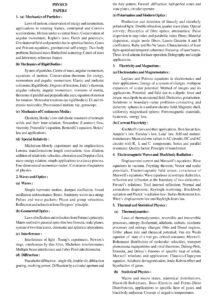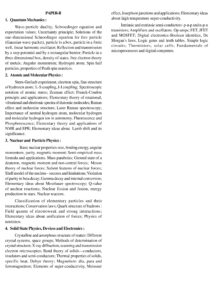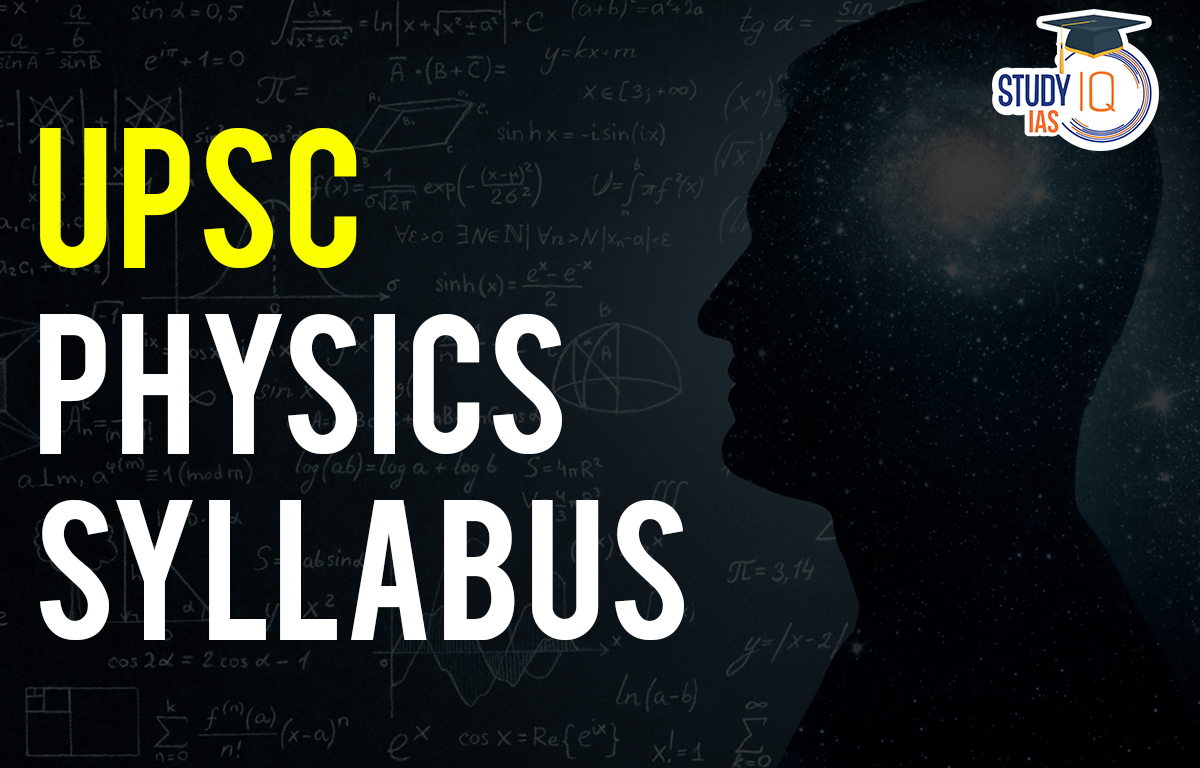Table of Contents
UPSC Physics Syllabus
Physics is a highly specialised subject for UPSC, and the syllabus is appropriate for candidates who have studied physics at the graduate level. This subject’s syllabus for the IAS exam includes statics and dynamics, thermodynamics, relativity, electricity and magnetism, quantum theory, and solid-state semiconductors, among other topics.
You can find the optional UPSC Physics Syllabus in this article. This article provides you with full information regarding the UPSC Physics syllabus that’s required to prepare for the UPSC Syllabus.
UPSC Physics Optional Syllabus
Physics is one of the optional subjects in the UPSC Civil Services Mains Exam, with two papers (Optional Paper I and Paper II). The UPSC Physics Syllabus for Optional is provided in this article. Each paper carries 250 marks, for a total of 500 marks. There are two optional papers that are part of the UPSC Mains’ nine subjective papers.
UPSC Physics Syllabus Paper 1
Candidates must approach the Physics Optional UPSC syllabus strategically because it is a specialist topic. In this subject paper, application-based questions are more frequently asked than theory-based questions. The UPSC Physics Syllabus Paper 1 consists of major topics such as Mechanics of Particles, Waves and Optics, Electricity and Magnetism, Electromagnetic Waves and Blackbody Radiation, Thermal and Statistical Physics
Candidates may find the detailed UPSC Physics Syllabus Paper 1 below:
1. (a) Mechanics of Particles:
Laws of motion; conservation of energy and momentum, applications to rotating frames, centripetal and Coriol accelerations; Motion under a central force; Conservation of angular momentum, Kepler’s laws; Fields and potentials; Gravitational field and potential due to spherical bodies, Gauss and Poisson equations, gravitational self-energy; Two-body problem; Reduced mass; Rutherford scattering; Centre of mass a laboratory reference frames.
(b) Mechanics of Rigid Bodies:
System of particles; Centre of mass, angular momentum, equations of motion; Conservation theorems for energy, momentum and angular momentum; Elastic and inelastic collisions; Rigid body; Degrees of freedom, Euler’s theorem, angular velocity, angular momentum, moments of inertia, theorems of parallel and perpendicular axes, equation of motion for rotation; Molecular rotations (as rigid bodies); Di and tri-atomic molecules; Processional motion; top, gyroscope.
(c) Mechanics of Continuous Media:
Elasticity, Hooke’s law and elastic constants of isotropic solids and their inter-relation; Streamline (Laminar) flow, viscosity, Poiseuille’s equation, Bernoulli’s equation, Stokes’ law and applications.
(d) Special Relativity:
Michelson-Morley experiment and its implications; Lorentz transformations-length contraction, time dilation, addition of relativistic velocities, aberration and Doppler effect, mass-energy relation, simple applications to a decay process; Four-dimensional momentum vector; Covariance of equations of physics.
2. Waves and Optics:
(a) Waves:
Simple harmonic motion, damped oscillation, forced oscillation and resonance; Beats; Stationary waves in a string; Pulses and wave packets; Phase and group velocities; Reflection and Refraction from Huygens’ principle.
(b) Geometrical Optics:
Laws of reflection and refraction from Fermat’s principle; Matrix method in paraxial optics-thin lens formula, nodal planes, a system of two thin lenses, chromatic and spherical aberrations.
(c) Interference:
Interference of light-Young’s experiment, Newton’s rings, interference by thin films, Michelson interferometer; Multiple beam interference and Fabry-Perot interferometer.
(d) Diffraction:
Fraunhofer diffraction-single slit, double slit, diffraction grating, resolving power; Diffraction by a circular aperture and the Airy pattern; Fresnel diffraction: half-period zones and zone plates, circular aperture.
(e) Polarization and Modern Optics:
Production and detection of linearly and circularly polarized light; Double refraction, quarter wave plate; Optical activity; Principles of fibre optics, attenuation; Pulse dispersion in step index and parabolic index fibres; Material dispersion, single mode fibres; Lasers-Einstein A and B coefficients; Ruby and He-Ne lasers; Characteristics of laser light-spatial and temporal coherence; Focusing of laser beams; Three-level scheme for laser operation; Holography and simple applications.
3. Electricity and Magnetism:
(a)Electrostatics and Magnetostatics:
Laplace and Poisson equations in electrostatics and their applications; Energy of a system of charges, multiple expansion of scalar potential; Method of images and its applications; Potential and field due to a dipole, force and torque on a dipole in an external field; Dielectrics, polarization; Solutions to boundary-value problems-conducting and dielectric spheres in a uniform electric field; Magnetic shell, uniformly magnetized sphere; Ferromagnetic materials, hysteresis, energy loss.
(b)Current Electricity:
Kirchhoff’s laws and their applications; Biot-Savart law, Ampere’s law, Faraday’s law, Lenz’s law; Self-and mutual-inductances; Mean and r m s values in AC circuits; DC and AC circuits with R, L and C components; Series and parallel resonances; Quality factor; Principle of the transformer.
4. Electromagnetic Waves and Blackbody Radiation:
Displacement current and Maxwell’s equations; Wave equations in vacuum, Pointing theorem; Vector and scalar potentials; Electromagnetic field tensor, the covariance of Maxwell’s equations; Wave equations in isotropic dielectrics, reflection and refraction at the boundary of two dielectrics; Fresnel’s relations; Total internal reflection; Normal and anomalous dispersion; Rayleigh scattering; Black body radiation and Planck’s radiation law, Stefan – Boltzmann law, Wien’s displacement law and Rayleigh-Jeans’ law.
5. Thermal and Statistical Physics:
(a)Thermodynamics:
Laws of thermodynamics, reversible and irreversible processes, entropy; Isothermal, adiabatic, isobaric, isochoric processes and entropy changes; Otto and Diesel engines, Gibbs’ phase rule and chemical potential; vander Waals equation of state of a real gas, critical constants; Maxwell-Boltzman distribution of molecular velocities, transport phenomena, equipartition and virial theorems; Dulong-Pet it , Einstein, and Debye’s theories of specific heat of solids; Maxwell relations and applications; Clausius- Clapeyron equation; Adiabatic de-magnetisation, Joule-Kelvin effect and liquefaction of gases.
(b)Statistical Physics:
Macro and micro states, statistical distributions, Maxwell-Boltzmann, Bose-Einstein and Fermi-Dirac distributions, applications to the specific heat of gases and black body radiation; Concept of negative temperatures.
UPSC Physics Optional Syllabus Paper 1 PDF
Candidates must approach the Physics Optional UPSC syllabus strategically because it is a specialist topic. In this subject paper, application-based questions are more frequently asked than theory-based questions. The UPSC Physics Syllabus Paper 1 consists of major topics such as Mechanics of Particles, Waves and Optics, Electricity and Magnetism, Electromagnetic Waves and Blackbody Radiation, Thermal and Statistical Physics
Candidates may find the detailed PDF for UPSC Physics Syllabus Paper 1 below:

UPSC Physics Syllabus Paper 2
Candidates must approach the Physics Optional UPSC syllabus strategically because it is a specialist topic. In this subject paper, application-based questions are more frequently asked than theory-based questions. The UPSC Physics Syllabus Paper 2 consists of major topics such as Quantum Mechanics, Atomic and Molecular Physics, Nuclear and Particle Physics, Solid State Physics, Devices, and Electronics
Candidates may find the detailed UPSC Physics Syllabus Paper 2 below:
1. Quantum Mechanics:
Wave-particle duality; Schroedinger equation and expectation values; Uncertainty principle; Solutions of the one-dimensional Schroedinger equation for a free particle (Gaussian wave-packet), particle in a box, particle in a finite well, linear harmonic oscillator; Reflection and transmission by a step potential and by a rectangular barrier; Particle in a three-dimensional box, density of states, free electron theory of metals; Angular momentum; Hydrogen atom; Spin half particles, properties of Pauli spin matrices.
2. Atomic and Molecular Physics:
Stern-Gerlach experiment, electron spin, fine structure of hydrogen atom; L-S coupling, J-J coupling; Spectroscopic notation of atomic states; Zeeman effect; Frank Condon principle and applications; Elementary theory of rotational, vibrational and electronic spectra of diatomic molecules; Raman effect and molecular structure; Laser Raman spectroscopy; Importance of neutral hydrogen atom, molecular hydrogen and molecular hydrogen ion in astronomy; Fluorescence and Phosphorescence; Elementary theory and applications of NMR and EPR; Elementary ideas about Lamb shift and its significance.
3. Nuclear and Particle Physics:
Basic nuclear properties-size, binding energy, angular momentum, parity, magnetic moment; Semi-empirical mass formula and applications, mass parabolas; Ground state of deuteron, magnetic moment and non-central forces; Meson theory of nuclear forces; Salient features of nuclear forces; Shell model of the nucleus – successes and limitations; Violation of parity in beta decay; Gamma decay and internal conversion; Elementary ideas about Mossbauer spectroscopy; Q-value of nuclear reactions; Nuclear fission and fusion, energy production in stars; Nuclear reactors.
Classification of elementary particles and their interactions ; Conservation laws ; Quark structure of hadrons; Field quanta of electro weak and strong interactions; Elementary ideas about unification of forces; Physics of neutrinos.
4. Solid State Physics, Devices and Electronics:
Crystalline and amorphous structure of matter; Different crystal systems, space groups; Methods of determination of crystal structure; X-ray diffraction, scanning and transmission electron microcopies; Band theory of solids – conductors, insulators and semiconductors; Thermal properties of solids, specific heat, Debye theory; Magnetism:para and ferro magnetism; Elements of superconductivity, Meissner effect, Josephson junctions and applications; Elementary ideas about high temperature superconductivity.
Intrinsic and extrinsic semiconductors; pn-p and n-p-n transistors; Amplifiers and oscillators; Op-amps; FET, JFET and MOSFET; Digital electronics-Boolean identities, De Morgan’s laws, logic gates and truth tables; Simple logic circuits; Thermostats, solar cells; Fundamentals of microprocessors and digital computers.
UPSC Physics Optional Syllabus Paper 2 PDF
Candidates must approach the Physics Optional UPSC syllabus strategically because it is a specialist topic. In this subject paper, application-based questions are more frequently asked than theory-based questions. The UPSC Physics Syllabus Paper 2 consists of major topics such as Quantum Mechanics, Atomic and Molecular Physics, Nuclear and Particle Physics, Solid State Physics, Devices, and Electronics.
Candidates may find the detailed PDF for UPSC Physics Syllabus Paper 2 below:

This article discusses the complete UPSC Physics syllabus for UPSC/IAS. candidates can download the PDF in this article. For more details related to UPSC Examination; students can visit the official website of StudyIQ UPSC Online Coaching.


 Daily Quiz 03 July 2025
Daily Quiz 03 July 2025
 Dalai Lama Confirms He will have a Succe...
Dalai Lama Confirms He will have a Succe...
 List of Awards and Honours Received by N...
List of Awards and Honours Received by N...





















